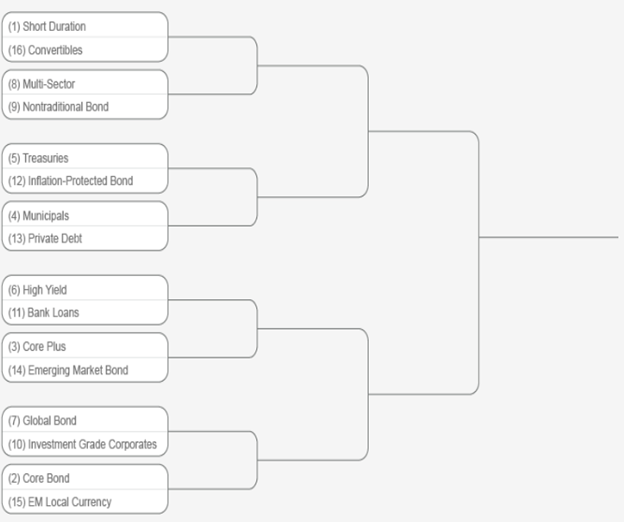The Fed looms large over fixed income as markets await highly anticipated rate cuts later this year. It makes timing bond exposures difficult, as well as deciding what bond investments are strong both near- and longer-term.
Enter the Bond March Madness from Mark J. Cintolo, CFA, CAIA, VP, and portfolio consultant at Natixis Investment Managers Solutions. Cintolo crafted a simulated bracket competition for various bond exposures. The bracket pits different bonds head-to-head and analyzes which is better for the current market environment.

Image source: Natixis Investment Managers
Round 1 Winners
In the first round, short-duration bonds took on convertibles. While convertibles sometimes benefit from volatility, it’s generally only during risk-on periods. For periods of risk-off, such as the onset of COVID-19 or the Great Financial Crisis, convertibles bleed a sizeable amount. Meanwhile, short-duration bonds do equally well during periods of volatility. You need look no further than last year to see investor benefits, making them a round one winner.
Next up, TIPS squared up with Treasuries. TIPS offers a long history of outperformance over Treasuries in 16 of the 22 previous years. The 4.4% nominal yield in Treasuries proved appealing, but CPI + 2% yields in TIPS clutched the inflation-protected bonds the win.
Municipal bonds met their match against private debt in the first round. Despite the not-insignificant tax yield of a muni bond, the considerable 6% and above pre-tax yield of private debt made up for added credit risk. With private debt offering the potential of up to double that pre-tax yield, it proved a clean sweep.
Nontraditional bonds beat out the multi-sector bonds on lower duration and better credit quality in 2024. Bank loans prove a better bet this year for investors that “think we avoid a major growth scare and want a carry trade for your bond portfolio” over high yield, explained Cintolo.
The high spread duration for EM bonds makes them poor competition for core plus this year. Meanwhile, with sovereign debt offering lower yields compared to the U.S., core bonds come out ahead this year over EM local currency bonds. Likewise, global bonds have lost out to investment-grade corporates, up 22% on an aggregate basis over the last eight years.
Round Two 2024 Bond Winners
Short-duration bonds look well positioned should the yield curve normalize, and the U.S. manage to sidestep recession. However, given Natixis’ 5-year expected return for cash of just 3.9% for short-duration bonds, nontraditional bonds benefit longer-term. “Loading up on short duration is trying to build a big halftime lead and then running out of steam down the stretch,” said Cintolo.
Private debt and TIPS offer appeal this year should inflation prove problematic. However, given its historic performance in 2022, when TIPS fell 14% while private debt rose 3%, private debt clinched the win for exposures this year.
Concerns of stock-bond correlations continue to plague markets this year. Cintolo attributes high loan yields and high prices to a lack of a growth scare. “I’ll take the better defense and a liquidity profile that can withstand SEC opposition,” Cintolo wrote. In a match between core plus and bank loans, core plus comes out ahead for its defensive play.
The match-up between core bonds and investment-grade corporates is a close one this year. As corporate spreads tighten, greater bond diversity becomes important. This typically favors Treasuries and mortgage-backed securities. It leaves core bond exposures better positioned in 2024.
Semi-Finals and Finalist
Private debt succumbed to nontraditional bonds in the semi-finals in a narrow race. Both performed better than the Bloomberg Aggregate Bond Index in the last three. Both also offer consistent performance in rangebound and rising yield environments. However, private debt investing requires deeper under-the-hood knowledge.
Private debt investors need to understand managers’ track records in default cycles, the leverage within the strategy, and whether actual diversification has been added. This makes nontraditional bonds the overall better investment this year.
In the second semi-final match-up, core bonds took on core plus. Both currently offer investors yields greater than 4% with similar duration and sector profiles. However, core plus offers strong outperformance potential in the period after spread events. In the wake of the COVID-19 volatility onset, core plus beat core bonds by 4%. “If you can’t time the market, how about something that looks similar today, with the flexibility to deploy dry powder later?” Cintolo noted.
The two most attractive bond allocations this year are nontraditional bonds and core plus bonds. Much remains unknown about the Fed’s ability to actually manage a soft landing. Recession risk has been pushed back but still is a viable potential outcome. Investors continue to find themselves weighing the potential for either outcome when investing.
“No matter which side you find yourself on, core plus has something for you,” Cintolo explained. Core plus offers duration benefits to counter equity risk, with spread exposure and active management to compensate for market dislocations. What’s more, they offer “an attractive carry if we push this out even further and have another yield-like return in 2024.”
For more news, information, and analysis, visit the Portfolio Construction Channel.

